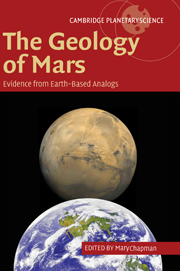Book contents
- Frontmatter
- Contents
- Preface: the rationale for planetary analog studies
- List of contributors
- 1 The geology of Mars: new insights and outstanding questions
- 2 Impact structures on Earth and Mars
- 3 Terrestrial analogs to the calderas of the Tharsis volcanoes on Mars
- 4 Volcanic features of New Mexico analogous to volcanic features on Mars
- 5 Comparison of flood lavas on Earth and Mars
- 6 Rootless volcanic cones in Iceland and on Mars
- 7 Mars interior layered deposits and terrestrial sub-ice volcanoes compared: observations and interpretations of similar geomorphic characteristics
- 8 Lava—sediment interactions on Mars: evidence and consequences
- 9 Eolian dunes and deposits in the western United States as analogs to wind-related features on Mars
- 10 Debris flows in Greenland and on Mars
- 11 Siberian rivers and Martian outflow channels: an analogy
- 12 Formation of valleys and cataclysmic flood channels on Earth and Mars
- 13 Playa environments on Earth: possible analogs for Mars
- 14 Signatures of habitats and life in Earth's high-altitude lakes: clues to Noachian aqueous environments on Mars
- 15 The Canyonlands model for planetary grabens: revised physical basis and implications
- 16 Geochemical analogs and Martian meteorites
- 17 Integrated analog mission design for planetary exploration with humans and robots
- Index
- Plate section
- References
4 - Volcanic features of New Mexico analogous to volcanic features on Mars
Published online by Cambridge University Press: 18 September 2009
- Frontmatter
- Contents
- Preface: the rationale for planetary analog studies
- List of contributors
- 1 The geology of Mars: new insights and outstanding questions
- 2 Impact structures on Earth and Mars
- 3 Terrestrial analogs to the calderas of the Tharsis volcanoes on Mars
- 4 Volcanic features of New Mexico analogous to volcanic features on Mars
- 5 Comparison of flood lavas on Earth and Mars
- 6 Rootless volcanic cones in Iceland and on Mars
- 7 Mars interior layered deposits and terrestrial sub-ice volcanoes compared: observations and interpretations of similar geomorphic characteristics
- 8 Lava—sediment interactions on Mars: evidence and consequences
- 9 Eolian dunes and deposits in the western United States as analogs to wind-related features on Mars
- 10 Debris flows in Greenland and on Mars
- 11 Siberian rivers and Martian outflow channels: an analogy
- 12 Formation of valleys and cataclysmic flood channels on Earth and Mars
- 13 Playa environments on Earth: possible analogs for Mars
- 14 Signatures of habitats and life in Earth's high-altitude lakes: clues to Noachian aqueous environments on Mars
- 15 The Canyonlands model for planetary grabens: revised physical basis and implications
- 16 Geochemical analogs and Martian meteorites
- 17 Integrated analog mission design for planetary exploration with humans and robots
- Index
- Plate section
- References
Summary
Introduction
The arid climate, extensional rift setting, range in type and age of volcanic eruptions, and generally widespread and geologically youthful volcanism in New Mexico contribute to an environment rich in geologic processes and landforms analogous to many of those on Mars. Young (<5 Ma) volcanoes and associated volcanic rocks are more widely distributed throughout the state than in many other volcanic localities on the North American continent. All of the principal volcanic landforms occur including long lava flows, viscous domes, calderas, composite volcanoes, monogenetic scoria cones, small shield volcanoes, and numerous hydromagmatic vents. The morphologies, volcanic emplacement processes, and dissected structures, and the arid environment, result in many volcanic landforms analogous to those on Mars. These features provide some clues to the details of geologic processes responsible for their Martian counterparts that are uncommon in areas where volcanism is less abundant and where the environments are less arid.
The largest young caldera (Valles Caldera), largest young lava flows (McCartys and Carrizozo), abundance of Quaternary volcanic fields, volatile-rich magmatism, including non-juvenile (maars) and juvenile types (Shiprock-Narbona Pass), spring deposits, and one of the great modern rift valleys on Earth (Rio Grande rift) occur in an arid setting where annual precipitation is between 8 and 15 inches (20–40 cm) per year. Combined with arid dissection and eolian in-fill, these contribute to a landscape that mimics the appearance of many volcanic terrains on Mars.
- Type
- Chapter
- Information
- The Geology of MarsEvidence from Earth-Based Analogs, pp. 95 - 125Publisher: Cambridge University PressPrint publication year: 2007
References
- 6
- Cited by



